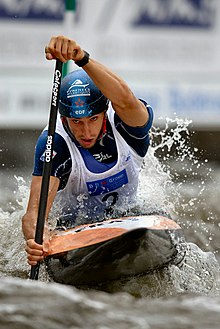Canadians

A one-canoe (C1) (also one-canoe or one- canoe ) is a canoe designed for a single driver (as opposed to a two-person canoe , etc.). The one-Canadier is a boat class in canoeing and as a competitive discipline in the canoe racing , canoe Marathon , Slalom , whitewater racing and Playboating driven (canoe Freestyle).
The one-canoe is moved with a paddle . Traditionally, the paddler sits on his cross-legged legs ( shins ) in a single canoe ; a special seat is usually used for this. In modern racing boats, the canoeist kneels on one leg and raises the other leg. In the leisure sector, one-Canadians are often provided with a low bench so that the driver does not have to sit on his knees.
technology
The technology varies depending on the boat and use.
On tame water (shallow rivers, lakes, etc.), the paddle in a single canoe can always be used on the same side (right or left) of the paddler. A special steering stroke ( J-stroke ) ensures that the boat runs straight ahead . In racing in particular, many experienced paddlers have specialized in one side that they have difficulty keeping the boat in balance when paddling on the other side. Many recreational or less experienced riders generally only paddle on one side, but change this side after a certain time; this keeps the physical strain more even.
In white water , especially in canoe slalom or canoe freestyle , canoeists also use extended paddle strokes . This enables faster changes of direction and generally faster and more powerful reactions.
Lone Canadians are rarely paddled on the coast, where kayaks are generally preferred. However, Canadians can be seen every now and then, especially in North America. In general, coastal paddling corresponds to tame and whitewater: On longer stretches without strong waves, the Canadian can be paddled on one side. For tighter turns or generally quick reactions to currents or waves, however, overlapping paddle strokes may also be necessary.
Disciplines
The men's single canoe is an Olympic sport in canoe racing (500 and 1000 m) and canoe slalom . The women's singles canoe has been part of the competition program of the International Canoe Federation (ICF) since 2010, and the new women's singles canoe discipline will be included in the program from the Tokyo 2020 summer games.
In freestyle, the C1 is driven as a mixed class, i.e. women and men compete against each other in the same rating.
Boat dimensions
The C1 in canoe racing and canoe marathon is a maximum of 520 cm long and has a minimum weight of 14 kg in racing or 10 kg in marathon. The boat width has not been fixed since 2001 and has since decreased. Andreas Dittmer's boat z. B. measures 35 cm at the widest point.
In the canoe slalom, too, the boat dimensions are standardized internationally by competition regulations. The single canoe must be at least 350 cm long and 60 cm wide and weigh 9 kg.
In white water racing, a single canoe must be 430 cm long and 70 cm wide and weigh 12 kg.
In freestyle (Kanurodeo) the boat dimensions, as the name suggests, are not fixed. Modern rodeo boats, however, all measure well below two meters. The same boats are used as for K1 canoeists, only the interior is adapted.

